Global Boardroom Diversity: Trends and Updates from the Diligent Institute
Over the last few years, companies have faced increasing pressure from shareholders, governments, regulators, employees, customers, and other stakeholders to improve their records on boardroom diversity. In light of these pressures, we wanted to take a closer look at the current state of boardroom diversity and inclusion, looking at elements like gender, age, and expertise across companies located in Europe, the United States, Canada, and Australia. Additionally, we took a deep-dive into the potential overboarding of directors, and which sectors lead in appointing diverse directors.
We reviewed 5,007 public companies headquartered in Austria, Belgium, Denmark, Finland, France, Germany, Ireland, Italy, Netherlands, Norway, Spain, Sweden, Switzerland, United Kingdom (UK), United States(US), Canada, and Australia for comparison, analyzing trends from January 2019 to June 2021. We found that:
- France continues to have the highest percentage of female representation on board in our sample, with 43 percent of board seats being held by women in 2021. At the other end of the spectrum, Austria lags the other countries in our sample with 21 percent of board seats being held by women.
- The average age of board members is rising, moving from 58.9 years in 2020 to 59.6 years in 2021. The financial sector has the highest average director age, at 62.84 years. Women directors are younger on average compared to their male counterparts: The average age of a female director is 59.33 years and the average age of a male director is 62.91 years.
- EU companies collectively trail the 40 percent target for female representation set by the European commission. Current average female representation is 31 percent across the region.
- Sweden and UK have the highest number of overboarded directors in Europe. 11 percent and 8 percent of directors are considered as overboarded by our in-house policy respectively[1].
France Remains the Country with the Highest Percentage of Female Representation
Our findings suggest that France continues to have the highest female representation on board. Women held 41.8 percent of board seats in our sample in 2019 and 43.1 percent in 2021.
In the United Kingdom, we found significant growth in female representation on boards. From 2019 to 2020, the percentage of board seats held by women increased from 26.4 percent to 30 percent. As of June 2021, the percentage is now 32 percent.
In Canada, our data suggests that female inclusion in the boardroom is steadily rising. From 2019 to 2020, the average percent of board seats held by women moved from 24.5 percent to 27.4 percent, an increase of 2.9 percentage points.
The country with the lowest female representation in the boardroom is Austria, with women holding only 21 percent of the country’s board seats in our sample, lagging the 30 percent national quota prescribed for their supervisory boards.
Across all countries surveyed and examined in our sample, women currently account for 36 percent of new board appointments, up from 34 percent in 2020.
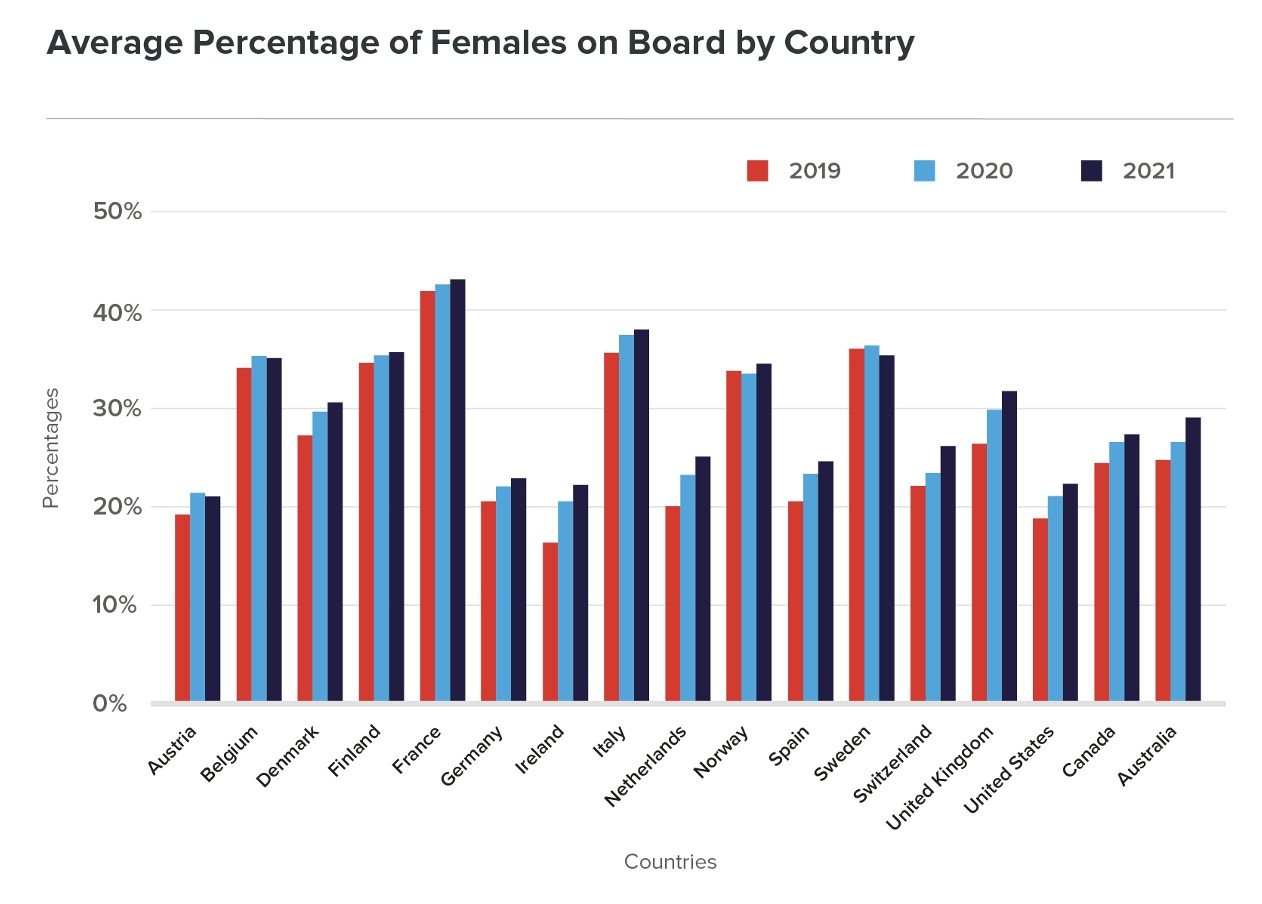
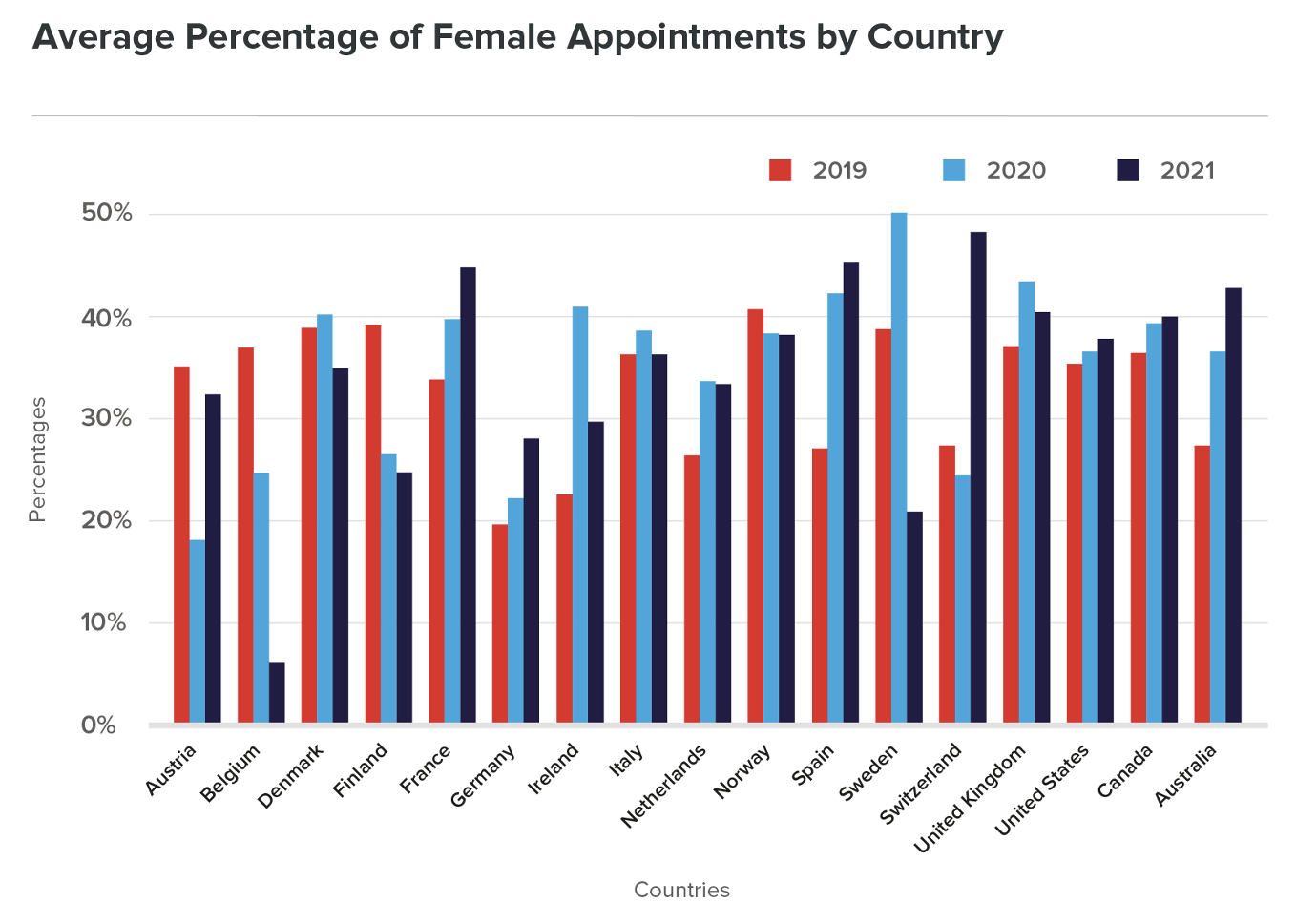
All-Male Boards Persist For Some Companies
Our data and analysis suggest that 204 companies in the US, 140 of which are in the Russell 3000, have no female representation on their boards. The S&P/TSX Composite has only one company with no female representation. In the United Kingdom, no FTSE 350 company has an all-male board. However, 13 companies in the FTSE Small Cap have no female representation. The S&P/ASX 300 in Australia has a total of 10 companies with have all-male boards. |
The Average Age of Board Members is Rising
Overall, average director age is 59.62 years, up from 58.92 in 2020. The average age of directors in the United States is 63.34 years, up from 62.64 years in 2020: the highest among the countries in our sample. The country with the lowest average age is Germany, where the average age of directors is 56.86 years, up from 56.13 years in 2020.
Overall, the age bracket with the highest representation is the 50-65 year age range. The age bracket “under 35 years” has the lowest representation across our sample space. Currently, only 129 directors fall under that age bracket out of 41,553 directors studied.

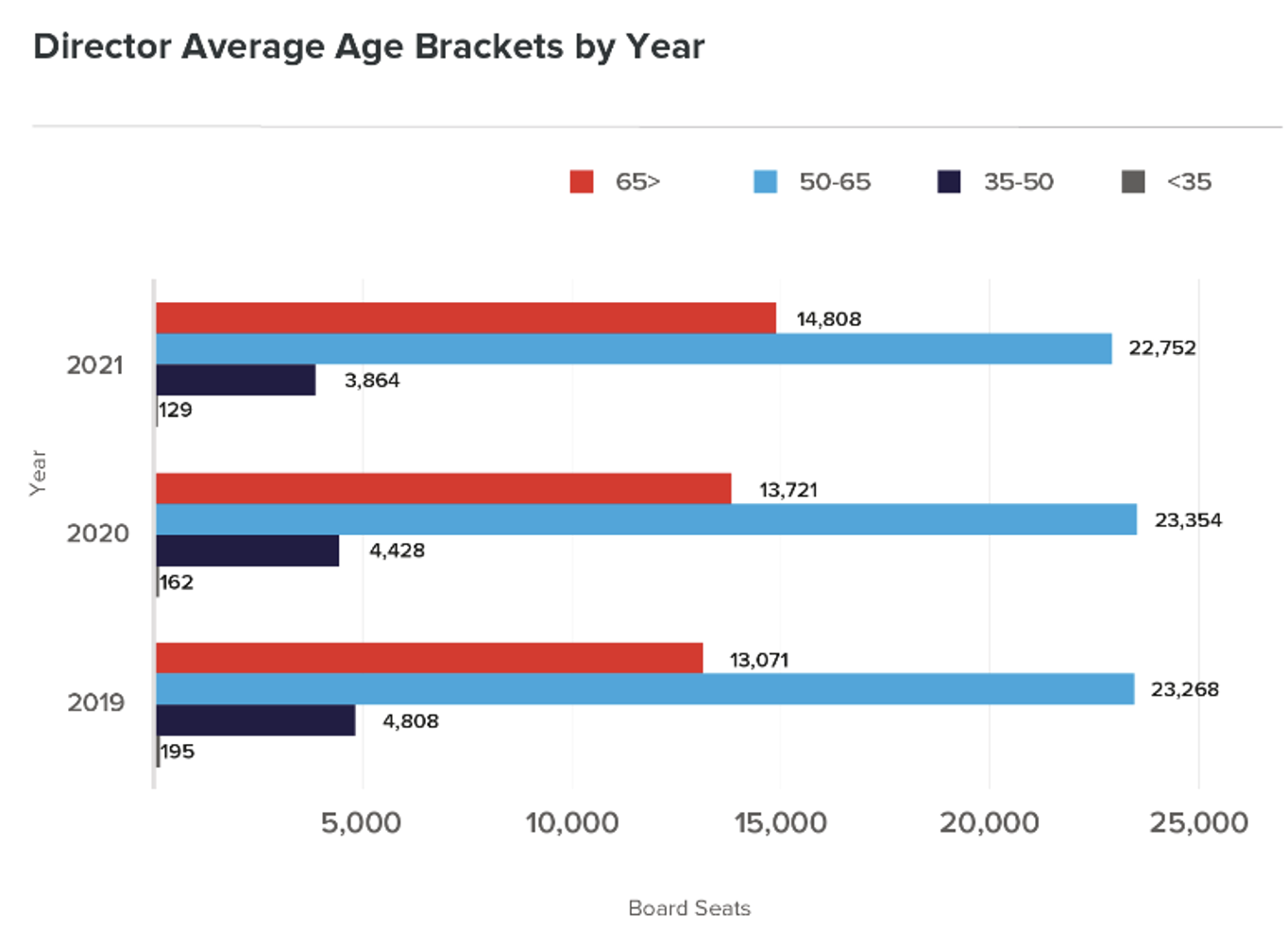
Financial sector has relatively older directors from 2019-2021
Our data suggests that the financial sector has the highest average director age from 2019 to June 2021, at 62.84 years, up from 61.64 years in 2019. The sector with the lowest average age of directors is the communication services sector. Interestingly, the average age of directors in this sector seems to be rising, moving from 58.77 years in 2019 to 60.15 years in 2021.
The data also suggests that the energy sector has the highest percentage (approximately 4 percent) of companies with directors in all age brackets. Comparatively, the healthcare sector has less than 1 percent (0.78 percent) of companies that have directors in all age brackets.
The financial sector and information technology sector has less than 2 percent of companies with directors in all age brackets with 1.49 percent and 1.19 percent respectively.

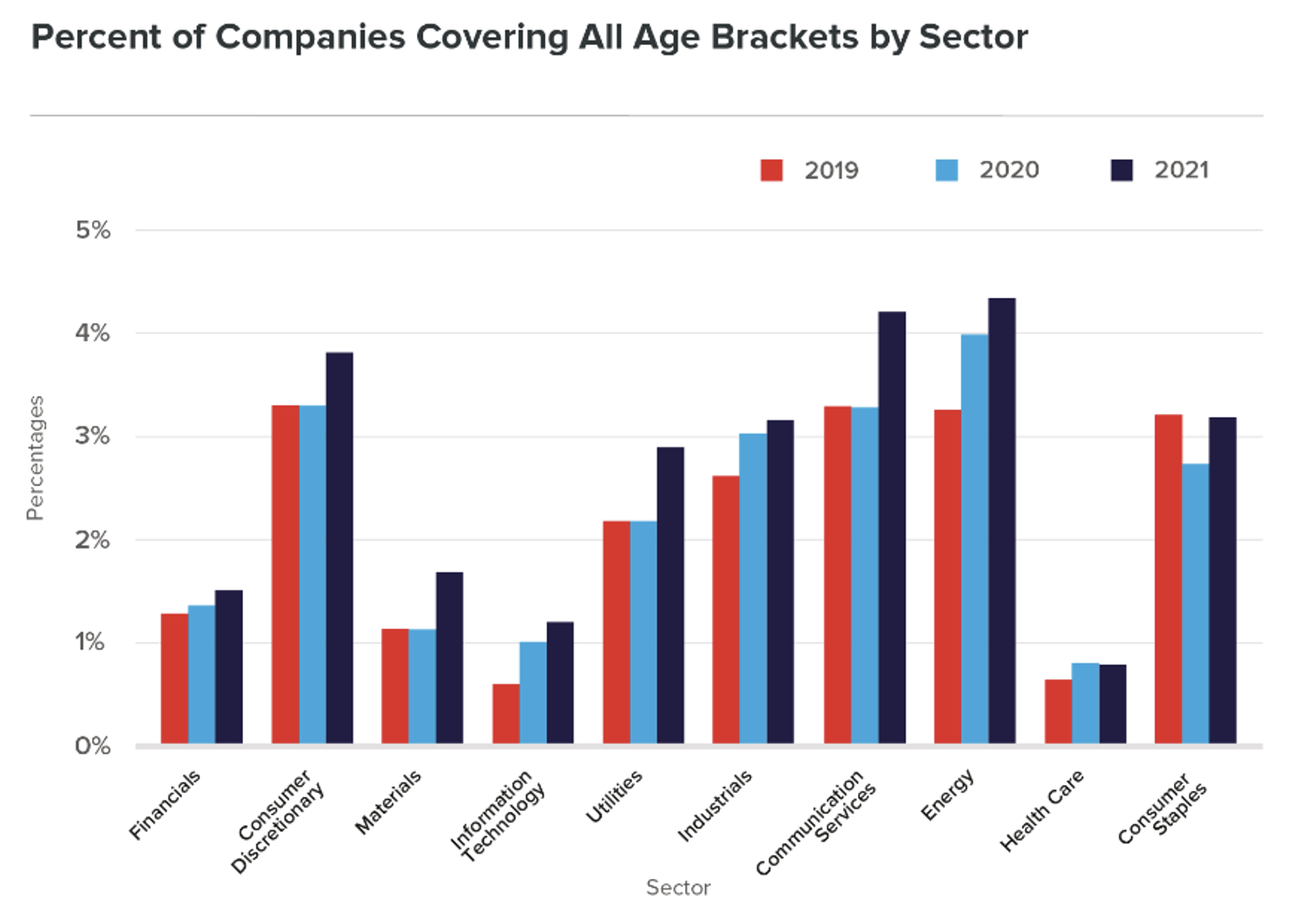
Across a total of over 41,000 directors studied, the findings suggest that female directors are considerably younger than their male counterparts. In 2019, the average age of a female director across our sample was 57.97 years compared to 61.74 years for male directors. Both indicators however climbed to 58.57 years and 62.22 years respectively in 2020. As of June 2021, the average age of a female director is 59.33 years, 3.58 years lower than the average age of a male director at 62.91 years. |
Overboarding: How Many Boards Seats is Too Much for a Director?
The word “overboarded” is often used to refer to a director who sits on an excessive number of boards and is therefore unable to fulfil their responsibilities to the best of their abilities. We analyzed companies in various jurisdictions based on their own countries’ Corporate Governance Codes and our standard or policy[2]. In a situation where the Code is silent on overboarding, companies were rated on our in-house policy alone.
Sweden and UK stand out as having the highest number of overboarded directors in Europe
Our data suggests that Sweden and the United Kingdom have the highest percentage of overboarded directors according to our in-house policy. On average, 11 percent of directors in Sweden and 8 percent of directors in the UK are considered overboarded.
Female directors in these countries are also considered relatively overboarded compared to their counterparts in other countries. Using our in-house policy, we found that 3 percent and 2 percent of female directors in Sweden and the United Kingdom could be considered overboarded. Using their respective national codes, the percentage drops to 4 percent and 2 percent, respectively. Spain has the least number of directors considered overboarded based on both standards.
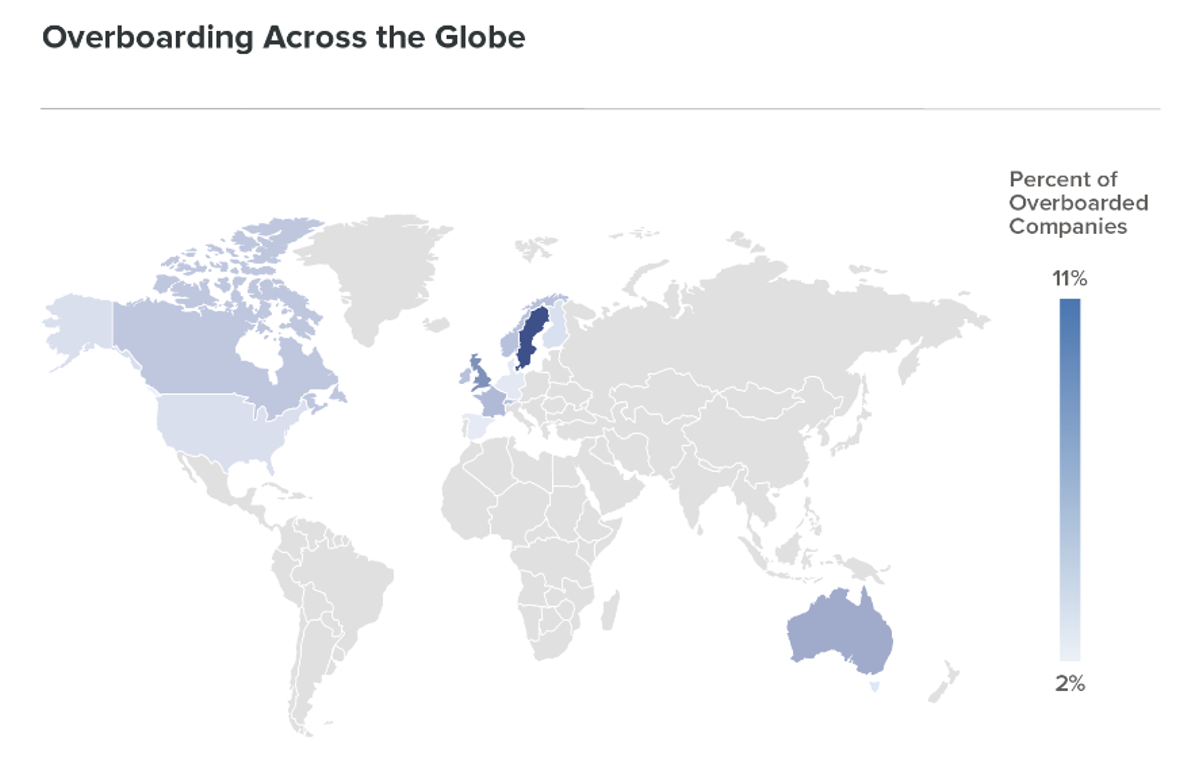
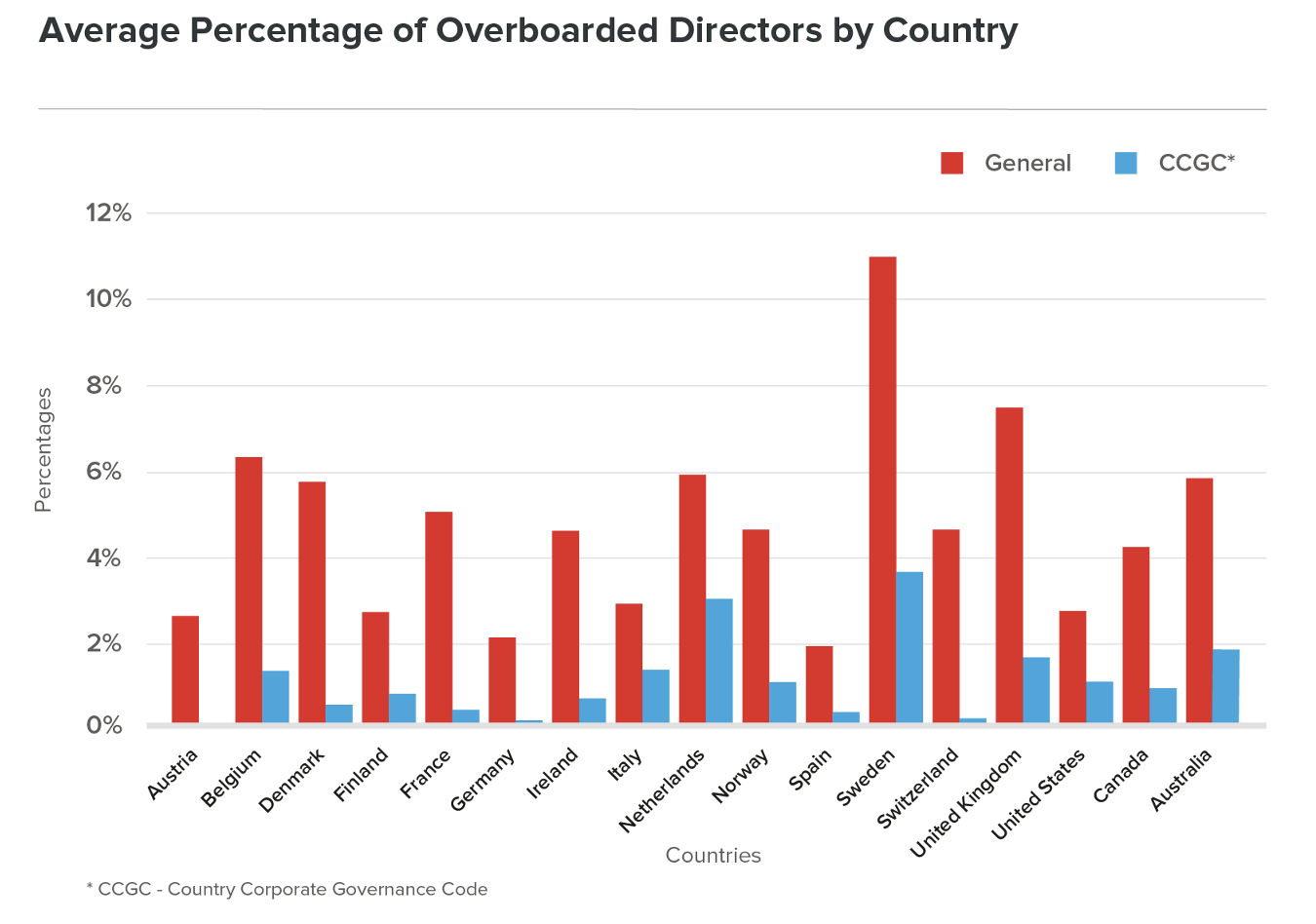
Which Skill Sets Are Represented on the Board?
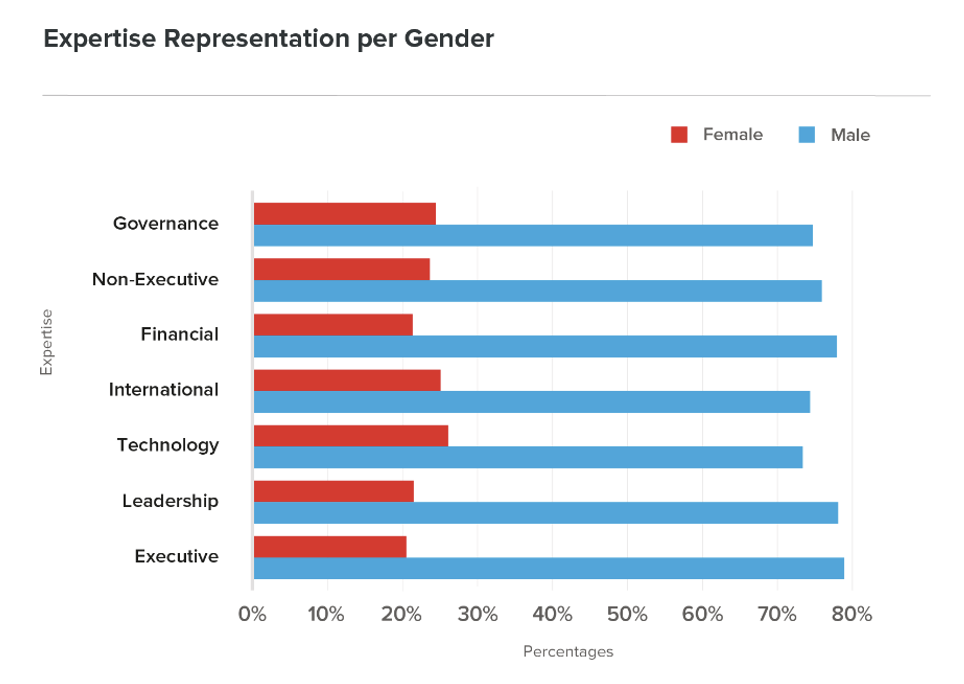
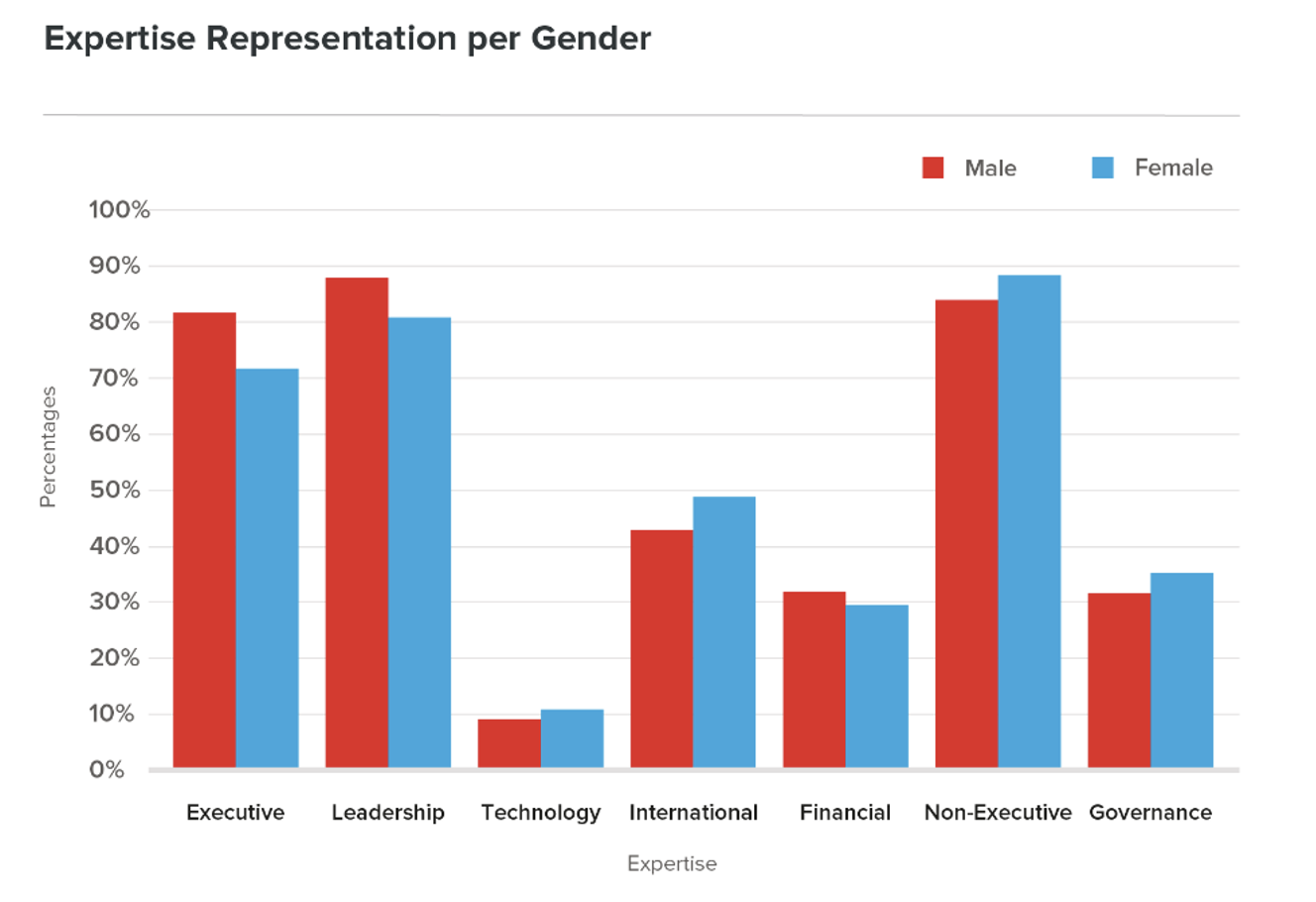
Our data suggests that 89 percent of all females on boards have non-executive expertise compared to approximately 84 percent of their male counterparts. This means that women are more likely to have non-traditional expertise backgrounds compared to men. Female representation is also higher in technology, international and governance expertise relative to other expertise backgrounds.
Understanding that director appointments with nontraditional (non-executive) backgrounds tend to be women can help your organization make more strategic hires. If you need to improve gender diversity on your board, but also need the perspectives of directors with different, more non-traditional skillsets, you may be able to solve for multiple elements of diversity with a single hire, thus diversifying the perspective of your board even more.
The Way Forward
Many companies now agree that diversity of perspective leads to more innovation, better risk management, and stronger connections with customers, employees, and business partners. While tremendous progress has been made, there is significant work yet to be done.
Continuous public debate is leading to countries worldwide addressing the issue on legislation level, as well as companies developing internal policies and incentives for corporate leaders to drive their businesses in more sustainable and inclusive directions.
The data and analysis explained above indicate that companies around the world are moving towards goals of gender equality on boards. However, many companies still trail national and supranational goals. In 2017, the European Commission (EC) announced that it would push for a mandatory gender diversity provision for company boards. The EC stated that companies with more than 60 percent of males on their boards should prioritize the recruitment of female candidates when filling open board positions. The EU has been pushing for a goal of at least 40 percent of women on company boards.
In 2020, the level of representation of women in European boards was 30 percent, up from 28 percent in 2019, falling behind the EC’s proposals by 10 percent. Even though female representation has increased to 31 percent in 2021, it still trails the quota set by the European Commission. Despite improvements, the data suggests that there is still much work to do until European boards reach their goal of 40 percent.
Quotas have been very influential in increasing female representation at board level in the United Kingdom, for example. From 2019 to 2020, we see quite a significant upsurge in female boardroom appointments, perhaps due to the soft deadline set by Lord Davies. In his final report, he included a new target for FTSE 350 companies of 33 percent female positions in board rooms by 2020. The new target was a strengthened quota after issuers in the FTSE 100 index reached the set target of 25 percent female representation in board rooms in 2015, a target which was set in 2011. Time will tell if similar regulations in the United States have similar effects.
About the Diligent Institute
Diligent Institute seeks to help corporate leaders be more effective by providing cutting-edge insights on corporate governance, by amplifying the voices of diverse corporate leaders, and by sharing broadly all that we are learning about modern governance practices.
Founded in 2018, Diligent Institute serves as the global corporate governance research arm and think tank of Diligent Corporation, the largest SaaS software company in the Governance, Risk and Compliance (GRC) space. We produce original research both on our own and in collaboration with partners, including institutions of higher education and thought leaders in the corporate governance space. We produce over a dozen reports each year, ranging from our monthly Director Confidence Index, which measures how corporate directors are feeling about the economy, to in-depth reviews of issues such as ESG (environment, social, governance) practices, to our AI-powered Corporate Sentiment Tracker that analyzes data from thousands of public sources to discern what’s on the minds of corporate leaders. Diligent Institute is funded solely by Diligent Corporation, the largest governance, risk and compliance (GRC) SaaS provider.
Learn more at diligentinstitute.com.
[1] Executive directors are considered overboarded if they hold more than two additional non-executive board positions at outside companies. (For the purpose of this research, a chairmanship position will count twice for a non-executive director position. For directors with no executive positions, they could hold up to four non-executive directorships in total
[2] In the interest of full disclosure, we defined a non-executive director to be overboarded if he/she holds more than four non-executive boards in total. Executive directors can also hold additional two other non-executive role
Published October 28, 2021.



